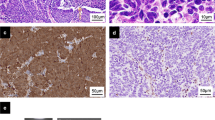Abstract
The Ras/Raf/MEK/ERK (MAPK) signal transduction cascade is an important mediator of a number of cellular fates including growth, survival and apoptosis. The aim of this study was to determine the incidence of B-raf, Kirsten-ras (K-ras) and Neuroblastoma-ras (N-ras) gene mutations in esophageal squamous cell carcinoma (ESCC) in the Greek population. DNA was extracted from 30 ESCC and 32 normal esophageal specimens and screened for V600E B-raf, and K-ras/N-ras codon 12 mutations, by PCR-RFLP based analysis. Among the genes tested, only the heterozygous K-ras mutation was detected in 5 out of the 30 ESCC specimens (16%), whereas no mutation was found in the normal esophageal tissue (P < 0.022). The normal samples were screened negative for N-ras and V600E B-raf mutations. The increased risk of esophageal cancer was correlated with tobacco use (OR = 3.5, P < 0.023) and alcohol abuse (OR = 7.22, P < 0.001), accompanied with the high incidence of the k-ras codon 12 mutation (22%, OR = 1.77 and 21%, OR = 1.52), respectively. A similar positive association was seen in human papilloma virus (HPV)-infected patients (OR = 5.66, P < 0.003). Our overall findings demonstrate that the mutational activation of the K-ras gene, HPV infection and tobacco or alcohol abuse, can be considered independently or in combination as high risk factors for ESCC development.


Similar content being viewed by others
References
Arber N, Shapira I, Ratan J et al (2000) Activation of c-K-ras mutations in human gastrointestinal tumors. Gastroenterology 118:1045–1050
Arora S, Mathew R, Mathur M et al (2001) Alterations in MDM2 in esophageal squamous cell carcinoma: relationship with p53 status. Pathol Oncol Res 7:203–208
Bosetti C, Gallus S, Garavello W et al (2006) Smoking cessation and the risk of oesophageal cancer: an overview of published studies. Oral Oncol 42:957–964
Fenoglio-Preiser CM (1999) Gastrointestinal pathology. An atlas and text, 2nd edn. Lippincott-Raven, Philadelphia, pp 102–103
Chetty R, Simelane S (1999) p53 and cyclin A protein expression in squamous carcinoma of the oesophagus. Pathol Oncol Res 5:193–196
Cohen Y, Xing M, Mambo E et al (2003) BRAF mutation in papillary thyroid carcinoma. J Natl Cancer Inst 95:625–627
Davies H, Bignell GR, Cox C et al (2002) Mutations of the BRAF gene in human cancer. Nature 417:949–954
Ellis A, Field JK, Field EA et al (1994) Tylosis associated with carcinoma of the oesophagus and oral leukoplakia in a large Liverpool family—a review of six generations. Eur J Cancer B Oral Oncol 30:102–112
Enzinger PC, Mayer RJ (2003) Esophageal cancer. N Engl J Med 349:2241–2252
Fransen K, Klintenas M, Osterstrom A et al (2004) Mutation analysis of the BRAF, ARAF and RAF-1 genes in human colorectal adenocarcinomas. Carcinogenesis 25:527–533
Garnett MJ, Marais R (2004) Guilty as charged: B-RAF is a human oncogene. Cancer Cell 6:313–319
Kim IJ, Park JH, Kang HC et al (2003) Mutational analysis of BRAF and K-ras in gastric cancers: absence of BRAF mutations in gastric cancers. Hum Genet 114:118–120
Lam AK (2000) Molecular biology of esophageal squamous cell carcinoma. Crit Rev Oncol Hematol 33:71–90
Lee SH, Lee JW, Soung YH et al (2003) BRAF and KRAS mutations in stomach cancer. Oncogene 22:6942–6945
Lord RV, O'Grady R, Sheehan C et al (2000) K-ras codon 12 mutations in Barrett’s oesophagus and adenocarcinomas of the oesophagus and oesophagogastric junction. J Gastroenterol Hepatol 15:730–736
Lyronis ID, Baritaki S, Bizakis I et al (2005) Evaluation of the prevalence of human papillomavirus and Epstein–Barr virus in esophageal squamous cell carcinomas. Int J Biol Markers 20:5–10
Mandard AM, Hainaut P, Hollstein M (2000) Genetic steps in the development of squamous cell carcinoma of the esophagus. Mutat Res 462:335–342
Mercer KE, Pritchard CA (2003) Raf proteins and cancer: B-Raf is identified as a mutational target. Biochim Biophys Acta 1653(1):25–40, Jun 5
Ramachandran S, Ramadas K, Hariharan R et al (2006) Single nucleotide polymorphisms of DNA repair genes XRC1 and XPD and its molecular mapping in Indian oral cancer. Oral Oncol 42:350–362
Scully C, Field JK, Tanzawa H (2000) Genetic aberrations in oral or head and neck squamous cell carcinoma 2: chromosomal aberrations. Oral Oncol 36:311–327
Sommerer F, Vieth M, Markwarth A et al (2004) Mutations of BRAF and KRAS2 in the development of Barrett’s adenocarcinoma. Oncogene 23:554–558
Spandidos DA, Sourvinos G, Tsatsanis C et al (2002) Normal ras genes: their onco-suppressor and pro-apoptotic functions (review). Int J Oncol 21:237–241
Syrjanen KJ (2002) HPV infections and oesophageal cancer. J Clin Pathol 55:721–728
Talamini G, Capelli P, Zamboni G et al (2000) Alcohol, smoking and papillomavirus infection as risk factors for esophageal squamous-cell papilloma and esophageal squamous-cell carcinoma in Italy. Int J Cancer 86:874–878
Tavani A, Bertuzzi M, Talamini R et al (2003) Coffee and tea intake and risk of oral, pharyngeal and esophageal cancer. Oral Oncol 39:695–700
Wang WKP, Schwartz M, Malon G et al (1994) PCR amplification of 40 year-old paraffin-embedded tumour tissues: comparison of four different DNA extraction and purification methods. Int J Oncol 5:0–4
Weber A, Langhanki L, Sommerer F et al (2003) Mutations of the BRAF gene in squamous cell carcinoma of the head and neck. Oncogene 22:4757–4759
Wu M, Semba S, Oue N et al (2004) BRAF/K-ras mutation, microsatellite instability, and promoter hypermethylation of hMLH1/MGMT in human gastric carcinomas. Gastric Cancer 7:246–253
Xing M (2005) BRAF mutation in thyroid cancer. Endocr-Relat Cancer 12:245–262
Acknowledgments
We acknowledge Dr. Maria Tsardi for the supply of the esophageal specimens from the Pathology department of the University hospital in Heraklion, Crete, Greece.
Author information
Authors and Affiliations
Corresponding author
Rights and permissions
About this article
Cite this article
Lyronis, I.D., Baritaki, S., Bizakis, I. et al. K-ras Mutation, HPV Infection and Smoking or Alcohol Abuse Positively Correlate with Esophageal Squamous Carcinoma. Pathol. Oncol. Res. 14, 267–273 (2008). https://doi.org/10.1007/s12253-008-9032-1
Received:
Accepted:
Published:
Issue Date:
DOI: https://doi.org/10.1007/s12253-008-9032-1




